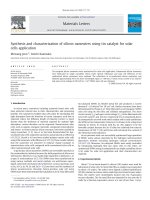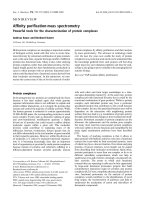Using Embedded Tools for I2C, SPI, and USB Debugging for the Renesas RX63N RDK_LabProcedures
Bạn đang xem bản rút gọn của tài liệu. Xem và tải ngay bản đầy đủ của tài liệu tại đây (94.97 KB, 2 trang )
Project Build Directions
Page 1 of 2
Using Embedded Tools for I2C, SPI, and USB
Debugging and Development for Renesas MCUs
Description: This lab asks participants to use Total Phase development tools to debug
I2C, SPI, and USB applications on the Renesas YRDKRX63N Demonstration Board.
This handout provides instructions on how rebuild a project after changes have been
made to the code.
Skill Level
Basic Knowledge of C, I2C, SPI, and USB protocols
Time to Complete Lab
120 Minutes
Lab Materials
Beagle USB 480 Protocol Analyzer
Beagle I2C/SPI Protocol Analyzer
Aardvark I2C/SPI Host Adapter
Renesas YRDKRX63N Demonstration Board
5 USB Cables
2 Mini-B USB Cable
High Speed Hub
MicroSD Card
Data Center Software for Beagle analyzers
Flash Center Software for Aardvark adapter
e2studio
Lab Objectives
1. Isolate individual problems within a system
2. Learn to debug USB using the Beagle USB
480 Protocol Analyzer
3. Program an EEPROM using the Aardvark
I2C/SPI Host Adapter
4. Debug I2C using the Beagle I2C/SPI
Protocol Analyzer
Project Build Directions
Page 2 of 2
Project Build Directions
Procedural Steps
Step 1. Save (Ctrl+S).
Step 2. Click Build All (Ctrl+B).
Step 3. Click Debug (F11) to download the module.
Step 4. Make sure the Renesas Debug “Perspective” (tab) is active, if it wasn’t selected
automatically. You can switch between the C/C++ and debug perspectives when you are
debugging to more easily search code etc.
Step 5. Hit Go (F8). If you hit a breakpoint that was left in a previous debug session, just hit Go
again. (To halt execution press the Pause symbol, NOT the red square which exits debug!)
After corrections are made to the source code, you will need to save, rebuild,
and load the project before moving to the next steps in the presentation. Follow the
steps below after you have made corrections to the source code.









